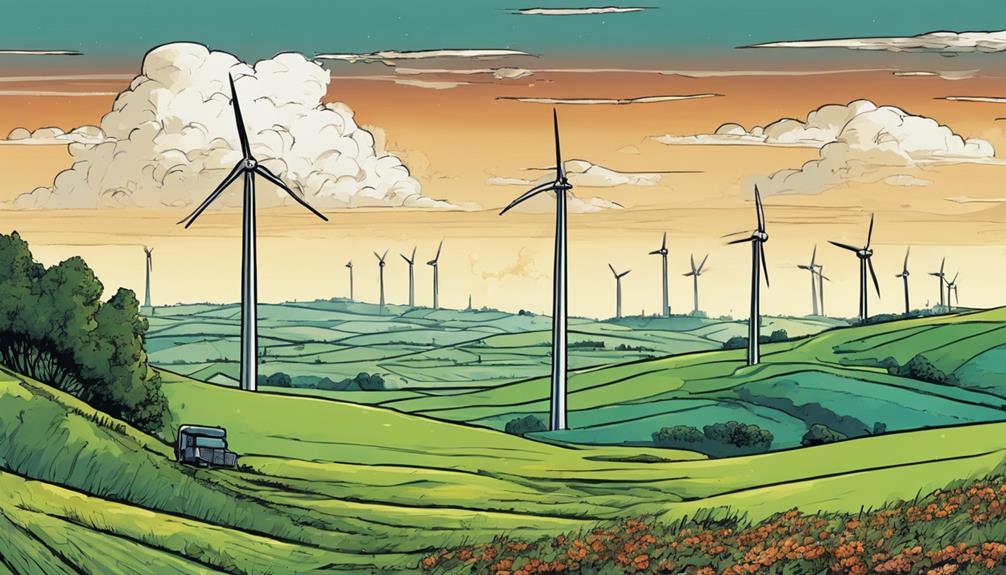We often overlook the critical role the sun plays in generating geothermal energy, but it's the sun's rays that initiate the process by heating the Earth's surface, which in turn drives the conduction of heat to subsurface layers, ultimately making geothermal power possible. The sun's energy is the spark that sets off a chain reaction, creating a temperature gradient that reaches the Earth's core. We'll explore how this process works, and why it's essential for a sustainable future. Let's dive deeper into the solar connection and uncover the full potential of geothermal energy.
Key Takeaways
- The Sun's energy initiates geothermal power by heating the Earth's surface, which is then transferred to subsurface layers through conduction.
- The Sun's rays warm the Earth's surface, creating a temperature gradient that eventually reaches the Earth's core, the source of geothermal energy.
- Solar geothermal integration is crucial, as it recognizes the Sun's role in enhancing the importance of renewable energy and mitigating climate change.
- The Sun's energy is harnessed for renewable and sustainable power through heat transfer and conduction, making geothermal energy possible.
- The Sun's vital force is leveraged in geothermal energy production, providing a cleaner and more sustainable alternative to fossil fuels.
The Solar Connection Explained

We often overlook the significant role the sun plays in geothermal energy, but understanding that the sun's energy is the initial driving force behind this renewable power source is crucial.
The sun's rays heat up the land and water on the Earth's surface, and this heat is then transferred to the subsurface layers through conduction. This process is what we call solar geothermal integration, and it's what makes geothermal energy possible.
Without the sun's energy, there would be no geothermal energy. It's as simple as that. By recognizing the sun's role, we can better appreciate the importance of harnessing this renewable energy source.
Heat Transfer and Conduction

As we explore further into the Earth's subsurface, we find that heat transfer and conduction play an important role in harnessing geothermal energy, allowing the sun's initial heat to permeate the planet's core. This process is vital in generating the heat that's utilized in geothermal systems.
The sun's rays warm the Earth's surface, causing the land and water to heat up.
This heat is then transferred to the subsurface layers through conduction, creating a temperature gradient.
As the heat moves deeper, it eventually reaches the Earth's core, the source of geothermal energy.
Through this process, the sun's energy is harnessed, providing a renewable and sustainable source of power.
Geothermal Energy Production

Now that we've investigated how the sun's warmth penetrates the Earth's core, let's explore how this warmth is harnessed and converted into usable geothermal energy.
We'll delve into the production process, which involves accessing underground reservoirs of hot water or steam. These reservoirs are typically located near tectonic plate boundaries, where the Earth's crust is thin and porous.
We'll discuss how geothermal power plants use heat exchangers to extract heat from the hot fluids, generating steam that drives turbines to produce electricity.
Additionally, we'll touch on the various applications of geothermal energy, including heating, cooling, and industrial processes.
Harnessing Renewable Energy

Our dependence on fossil fuels is gradually giving way to a cleaner, more sustainable approach, where harnessing renewable energy from geothermal sources plays a vital role in mitigating climate change.
As we shift our focus towards renewable energy, geothermal power emerges as an essential component of this transformation. By tapping into the Earth's internal heat, we can generate electricity, provide heating and cooling, and support various industrial processes.
- Imagine a world where homes are warmed and cooled using natural heat from the Earth's core.
- Picture a future where factories and farms are powered by clean, sustainable energy.
- Envision a landscape where geothermal power plants stand tall, generating electricity for entire communities.
- See a planet where our dependence on fossil fuels is a distant memory, replaced by a sustainable, renewable energy future.
Sustainable Energy Solutions

We're shifting towards sustainable energy solutions that leverage geothermal power to reduce our carbon footprint and create a cleaner, healthier environment.
By harnessing the sun's energy, we can tap into the Earth's natural heat to generate electricity, provide heating and cooling, and support various industrial processes.
Geothermal energy is a game-changer, offering a reliable and renewable source of power that's free from fossil fuels.
As we progress to a low-carbon economy, geothermal solutions will play a crucial role in reducing greenhouse gas emissions and mitigating climate change.
We're committed to exploring innovative ways to integrate geothermal energy into our daily lives, creating a sustainable future for generations to come.
Frequently Asked Questions
Can Geothermal Energy Be Used for Cooling Purposes Besides Heating?
We're wondering if geothermal energy is only good for heating, but the answer is no Since it can also be used for cooling purposes, we're excited to explore its versatile applications beyond just warming up spaces.
How Does Solar Geothermal Integration Impact the Environment?
Solar geothermal integration helps reduce our reliance on fossil fuels, decreasing greenhouse gas emissions and promoting a cleaner environment, which is a significant step towards a sustainable future.
Are Solar Geothermal Systems Viable for Remote or Off-Grid Locations?
"As we venture into the wilderness, we find that solar geothermal systems are our trusty compass, guiding us towards a viable option for remote or off-grid locations, illuminating the path to sustainable energy independence."
What Is the Typical Lifespan of a Solar Geothermal System?
"We're glad you asked As we explored the world of solar geothermal systems, we found that their typical lifespan ranges from 20 to 30 years, depending on factors like maintenance, quality, and usage."
Can Solar Geothermal Energy Be Stored for Later Use During Peak Demand?
We investigate if solar geothermal energy can be stored for later use, and yes, it can Thermal energy storage systems enable us to stockpile energy during off-peak hours, releasing it during peak demand, ensuring a reliable supply.
How Does the Sun Play a Role in the Environmental Impact of Geothermal Energy?
The sun influences the environmental impacts of geothermal energy. The sun’s heat warms the Earth’s crust, creating geothermal energy. Harnessing this power can have positive geothermal energy environmental impacts by reducing greenhouse gas emissions, but it can also have negative effects if not managed properly, such as releasing harmful gases and chemicals.
Conclusion
As we bask in the sun's warm glow, we're reminded that its energy is the spark that sets the geothermal engine in motion. Like a master conductor, the sun orchestrates the symphony of heat transfer, convection, and energy production.
And as we harness this renewable power, we're not just generating electricity – we're composing a brighter, more sustainable future. The sun's essential force is music to our ears, and we can't help but harmonize with its rhythm.









